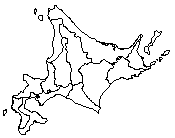
HOKKAIDO District
Hokkaido prefecture (sapporo)
*Weave*
( p. 33 )*

1. Produced in Asahikawa City, Hokkaido.
2. Characteristics: Kind of homespun woven with wool, silk and flax which are produced in
Hokkaido. The textile is light and has a warm touch with the picturesque designs of nature
in Hokkaido. The technique used is a hand woven brocade with raised designs.
3. Uses: "Obi"(sash), "haori(coat for kimono) coats, shawls, mufflers,
neckties, pouches and mats.
4. History: Production started around 1962 with a special wool of Hokkaido, as the main
material. "Yukar" means "legend" in the Ainu language.
*Weave*
( p.33 )

1. Produced in Siraoigun, Hokkaido .
2. Characteristics: An Ainu fabric woven with fibers from the bark of "Ohyo"
(Ulmus laciniata) a species of the elm tree. Textile is all hand woven with a primitive
loom. The cloth is used for a half length garment with half length sleeves, called "
Dofuku." It is embroidered patterns peculiar to the Ainu. The color of the cloth is
plain, black, gray or white.
3. Uses: Once used for formal and informal garments, now, for hoods, head bands, sashes,
aprons and so on. These are put on a model only for touristic events. Mats, wall carpets,
sashes and pouches are made for souvenir items.
4. History: The textile technique was on a high level in the Ainu culture and they
produced knitted pouches, ropes and mats. After the loom was introduced "Atsushi
Ori" became the main fabric for garments. Ohyo, which grew wild and abundantly in
Hokkaido, is now hard to obtain and another plant called "Shinanoki"(Tilia
japonica) similar to linden is used instead.
Last modified:10-December-1997



